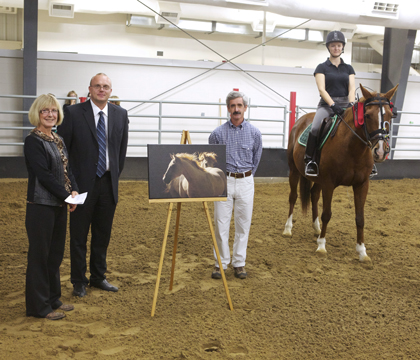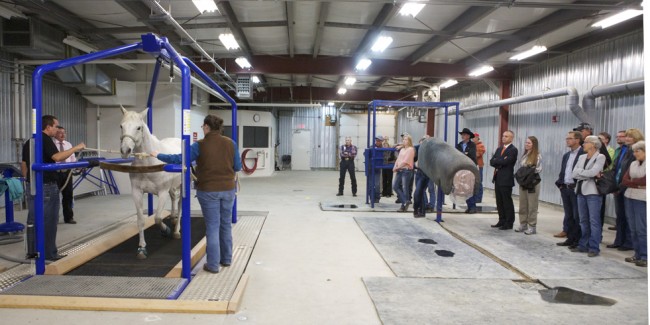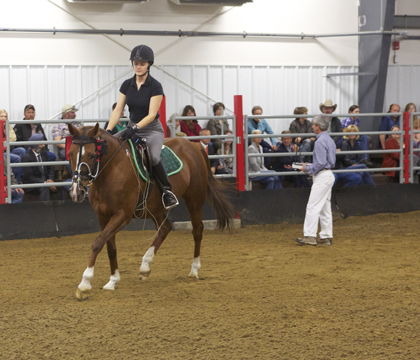
EFC’s $120,000 gift supports equine program
The Equine Foundation of Canada (EFC) gave another boost to horse health care in the country with its latest contribution of $120,000 to the Western College of Veterinary Medicine's equine health program.
By Lynne Gunville
The national organization's gifts were highlighted during a horse health evening on October 8 that was held in the WCVM's recently expanded Ryan/Dubé Equine Performance Centre.
"Having the WCVM acknowledge the Equine Foundation of Canada in the new building and in front of a bunch of our peers – that's as good as it gets!" says Dalen-Brown, who has represented the EFC at several other WCVM gift presentations over the past 15 years.
Overall, the EFC has donated more than $200,000 toward WCVM equipment purchases, research projects and scholarships during the past 40 years.
"I've been really blessed because I'm the person who gets to go to the college and give the cheques. I'm so lucky because I get to see how thankful the veterinary college and the veterinarians are."
The bulk of the group's most recent donation — $100,000 — was used to establish the Equine Foundation of Canada Graduate Student Scholarship. Each year, the veterinary college will award $3,500 to a graduate student who has demonstrated interest and scientific merit in equine research.
The remaining $20,000 went toward the purchase of a new standing endoscope — one of the diagnostic tools that was on display at the horse health evening.
During the event, Dalen-Brown and more than 70 other horse enthusiasts listened to a talk on lameness diagnostic techniques by Dr. James Carmalt, a board-certified equine surgeon at the WCVM. Another presentation on exercise induced pulmonary hemorrhage (EIPH) was delivered by Dr. Frederik Derksen, a renowned professor and researcher at Michigan State University.
Dr. David Wilson, a board-certified equine surgeon at the WCVM, also gave a demonstration of the college's new equine treadmill in the EPC.

In addition, the crowd watched Dr. Fernando Marqués, a board-certified specialist in internal medicine, give a demonstration of the WCVM's overground endoscope and Holter telemetry monitor with the help of "Nellie," a 19-year-old Thoroughbred mare that was ridden by her owner, field service clinical associate Dr. Anne Marie Guillemaud. Both pieces of equipment were purchased with a previous EFC donation of $20,000 that was matched by the Heather Ryan and David Dubé Foundation in 2011.
"At the end of the day, all donations such as these go back to our clients and general public by means of improving our diagnostic and treatment options for all horses around the world," says Marqués, chair of the WCVM Equine Health Research Fund and an associate professor of large animal internal medicine at the college.
WCVM clinicians welcome the addition of a standing endoscope because of the increased options it will provide for serving clients. While the overground endoscope is important for examining horses during exercise, the new endoscope will allow examinations of animals at rest and under sedation.

"Both types of endoscopes are complementary when evaluating upper airways in horses," explains Marqués. "Some pathologies are best seen at rest (resting endoscopic examination), but others are only detected during exercise (dynamic endoscopic examination)."
In addition to diagnosing respiratory conditions, veterinarians can use the standing endoscope to examine a portion of the equine esophagus as well as the urinary tract of adult mares, stallions and geldings.
"We see a high prevalence of respiratory conditions in horses in our area, mainly inflammatory in origin," Marqués says. "This endoscope, along with other diagnostic tools available to us, will allow us to investigate those conditions and understand the underlying mechanisms of disease."
The purchase of an additional endoscope also allows for more flexibility, adds Marqués. For example, field service clinicians can examine horses during field calls without affecting diagnostic exams scheduled in the Large Animal Clinic. Veterinary students also have more opportunities to learn from clinical cases and to practise endoscopies as they acquire their technical skills.
In addition, researchers can use the endoscope for their research projects while graduate students and residents will have more opportunities to investigate pathologies and normal characteristics of the upper airways of horses.
While Dalen-Brown enjoyed the opportunity to meet with other horse owners and get a first-hand look at the equipment in use, she was particularly pleased by the gift presentation and the recognition that the EFC received from the WCVM.
"It was a really fun event for me. I felt really well thanked for the gifts that the Equine Foundation of Canada has given to the WCVM over the years."
Visit www.equinefoundation.ca for more information about the EFC's donations and activities.
"Having the WCVM acknowledge the Equine Foundation of Canada in the new building and in front of a bunch of our peers – that's as good as it gets!" says Dalen-Brown, who has represented the EFC at several other WCVM gift presentations over the past 15 years.
Overall, the EFC has donated more than $200,000 toward WCVM equipment purchases, research projects and scholarships during the past 40 years.
"I've been really blessed because I'm the person who gets to go to the college and give the cheques. I'm so lucky because I get to see how thankful the veterinary college and the veterinarians are."
The bulk of the group's most recent donation — $100,000 — was used to establish the Equine Foundation of Canada Graduate Student Scholarship. Each year, the veterinary college will award $3,500 to a graduate student who has demonstrated interest and scientific merit in equine research.
The remaining $20,000 went toward the purchase of a new standing endoscope — one of the diagnostic tools that was on display at the horse health evening.
"At the end of the day, all donations such as these go back to our clients and general public by means of improving our diagnostic and treatment options for all horses around the world."
During the event, Dalen-Brown and more than 70 other horse enthusiasts listened to a talk on lameness diagnostic techniques by Dr. James Carmalt, a board-certified equine surgeon at the WCVM. Another presentation on exercise induced pulmonary hemorrhage (EIPH) was delivered by Dr. Frederik Derksen, a renowned professor and researcher at Michigan State University.
Dr. David Wilson, a board-certified equine surgeon at the WCVM, also gave a demonstration of the college's new equine treadmill in the EPC.

In addition, the crowd watched Dr. Fernando Marqués, a board-certified specialist in internal medicine, give a demonstration of the WCVM's overground endoscope and Holter telemetry monitor with the help of "Nellie," a 19-year-old Thoroughbred mare that was ridden by her owner, field service clinical associate Dr. Anne Marie Guillemaud. Both pieces of equipment were purchased with a previous EFC donation of $20,000 that was matched by the Heather Ryan and David Dubé Foundation in 2011.
"At the end of the day, all donations such as these go back to our clients and general public by means of improving our diagnostic and treatment options for all horses around the world," says Marqués, chair of the WCVM Equine Health Research Fund and an associate professor of large animal internal medicine at the college.
WCVM clinicians welcome the addition of a standing endoscope because of the increased options it will provide for serving clients. While the overground endoscope is important for examining horses during exercise, the new endoscope will allow examinations of animals at rest and under sedation.

"Both types of endoscopes are complementary when evaluating upper airways in horses," explains Marqués. "Some pathologies are best seen at rest (resting endoscopic examination), but others are only detected during exercise (dynamic endoscopic examination)."
In addition to diagnosing respiratory conditions, veterinarians can use the standing endoscope to examine a portion of the equine esophagus as well as the urinary tract of adult mares, stallions and geldings.
"We see a high prevalence of respiratory conditions in horses in our area, mainly inflammatory in origin," Marqués says. "This endoscope, along with other diagnostic tools available to us, will allow us to investigate those conditions and understand the underlying mechanisms of disease."
The purchase of an additional endoscope also allows for more flexibility, adds Marqués. For example, field service clinicians can examine horses during field calls without affecting diagnostic exams scheduled in the Large Animal Clinic. Veterinary students also have more opportunities to learn from clinical cases and to practise endoscopies as they acquire their technical skills.
In addition, researchers can use the endoscope for their research projects while graduate students and residents will have more opportunities to investigate pathologies and normal characteristics of the upper airways of horses.
While Dalen-Brown enjoyed the opportunity to meet with other horse owners and get a first-hand look at the equipment in use, she was particularly pleased by the gift presentation and the recognition that the EFC received from the WCVM.
"It was a really fun event for me. I felt really well thanked for the gifts that the Equine Foundation of Canada has given to the WCVM over the years."
Visit www.equinefoundation.ca for more information about the EFC's donations and activities.
